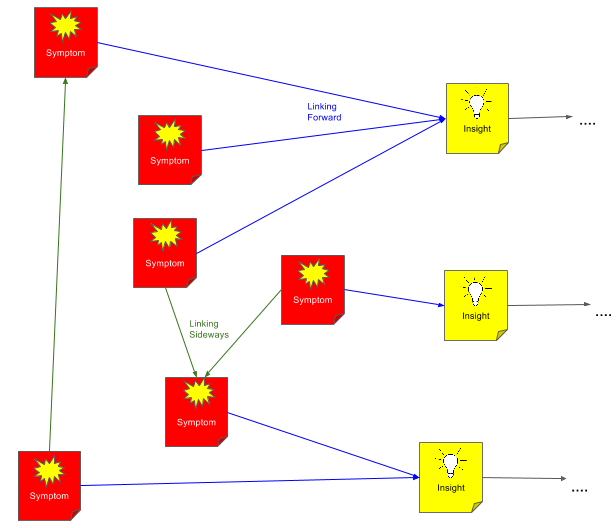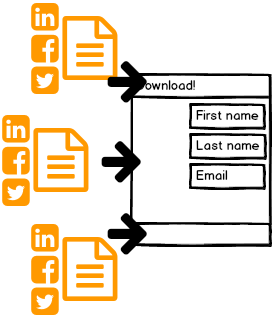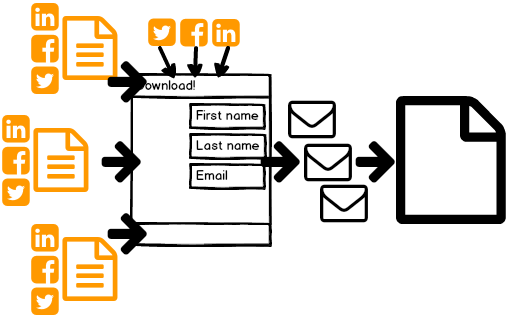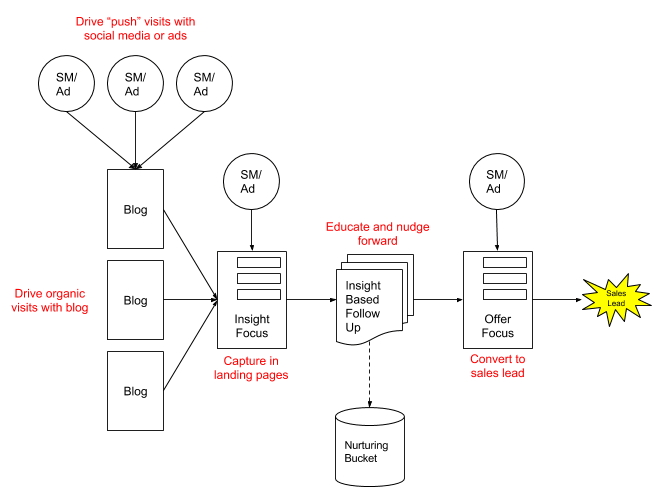What is a marketing automation funnel?
When you want answers today, you go to Google. From CXOs at global companies to employees at the bottom of the hierarchy.
If you understand your customers' searches, you can create customized Marketing Automation Funnels to capture and sell to these people.
How to do this? Read more.
Step 1: Attract your target audience
First, we need to make sure those searches go to us. And you do that by blogging. But not just blogging for the sake of blogging, but blogging with a purpose.
Write regular blog posts about questions that your target audience asks Google. This way you attract potential customers who don't know they are potential customers. Link between blog posts to guide visitors in the right direction (like I did there). In this way, you create a web of blog posts that capture visitors to your marketing automation system:

Exactly how to do that is described more in the article how to blog to generate traffic and leads. (See - I did it again! 🙂 ).
Step 2: Capturing visitors in your marketing automation flow
Then capture the visitors in automatic sales flows that you have built with your marketing automation system. Offer them solutions to the problems they searched for, in return for their email addresses. You do this on a landing page that contains a form:

Once you've captured them, it's time to educate them - give them insights to understand the issues in a new way.
Step 3: Give your leads insights into their problems
Create more material around the insights you want to educate your leads on. Not about your product, but about their original problem. This could be related videos, related articles, blog posts, or any other content you can think of. Email these insights to your target audience piecemeal over time.
But make sure your material opens their eyes. Don't just solve their problems, but show them the problems from a new perspective. A perspective they haven't thought about before. This is what smart marketing does: it captures customers who think they have problem A, but shows them that they actually have problem B.
If you have interesting content with valuable insights, you will gain a fan. And when they start seeing their problems from your point of view, you will have beaten out potential competitors.

Now it's time for the last step in your sales flow: selling!
Step 4: Sell with your funnel
In each email you make a call to action. Ask them to click on a link at the bottom to see how your products solve their problems. Because this is the ultimate purpose of all marketing: to sell.
If it is a potential customer, is ready, and your material has been interesting, they will click.
What you link to is no longer educational. Now you can start selling for real. What they click on is now traditional, product-based content that positions you as the best supplier. But because they have the right mindset, the material becomes so much more impactful.
Once they read this, your marketing automation system notifies your salespeople so they can make contact and close the deal. The entire flow, from start to finish, now looks like this:
The leads that have gone through this flow will be more open to dialog, interested in meeting, and have much shorter sales cycles because they already see the world the way you do.
What do we do with the leads we could not sell to?
Your marketing automation funnels will undoubtedly capture a lot of leads that are not potential customers. But they are also valuable!
Create your funnels so that they are placed in a special category that you can call your "fan club".
If you happen to catch competitors, you can use automation to lock them out of future mailings.
You can process partners with special partner flows.
You can treat promoters with news and insights over time, so they spread your message further.
And potential customers who weren't ready right now, you continue to approach them with interesting insights. From time to time, you encourage them to take action. When they're ready, they do, and your marketing automation system lets you know it's time to make contact.
How much additional sales can your marketing automation funnels provide?
How many leads can you get? How many of these can become business?
In general, there is a rule: The more expensive the product, the fewer leads. But the end result in terms of money is always about the same.
But to answer the question, let's take a company I helped that sold IT solutions with order values ranging from hundreds of thousands of dollars to millions. Here are their figures:
They receive an average of 22 visitors per month per blog post. These are the visits blog posts receive today, when they were written and published several years ago.
On average, 1.5% of visitors convert to leads via the initial educational offer. And from there, about 10% convert to sales-ready leads.
So: 10 blog posts give this company 10 x 22 x 1.5% x 10% = 0.3 sales-ready leads per month. With a closing rate of 20% (not at all unusual with such qualified leads) and an order value of SEK 500,000, this is SEK 30,000 per month.
If you blog once a week, you will have 50 blog posts after one is: €150,000 per month. By blogging once a week. An employee can blog 3 times a week and cost less. A clear ROI.
If you focus on building sales funnels, soon the question will no longer be "how do we get more leads?". It will be "how do we make the management of all the leads we get more efficient?". I've seen it happen. We had to hire dedicated salespeople who only handled our 70 leads per month.
And the answer will be the same answer that led us here in the first place: by using marketing automation to help salespeople become even more effective!


